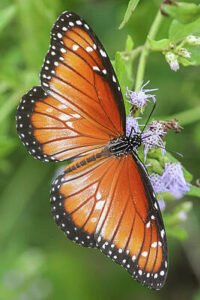compiled by Elmili TK
Butterfly populations across the United States are plummeting due to insecticides, climate change, and habitat destruction, with their numbers dropping by 22% since 2000, according to a new study published in Science. Researchers found that butterfly populations in the lower 48 states have been shrinking at an average rate of 1.3% per year, with 114 species in significant decline and only nine showing growth.
“Buttery populations have been steadily declining over the past two decades,” said study co-author Nick Haddad, an entomologist at Michigan State University. “And there’s no indication that this trend will reverse anytime soon.”
To reach their findings, scientists analyzed nearly 77,000 surveys from 35 monitoring programs, ultimately tracking 12.6 million butterflies over time. The study follows a separate report last month that revealed monarch butterfly numbers have plummeted to a near-record low, with fewer than 10,000 counted—down from 1.2 million in 1997. Many butterfly species have declined by 40% or more.
A ‘Catastrophic’ Decline in Butterfly Populations
While an annual decline of 1.3% may not seem drastic, University of Connecticut entomologist David Wagner warns that over time, the losses are devastating.
“In 30 to 40 years, we could lose half of the continent’s butterflies and countless other insects,” Wagner explained. “The tree of life is being stripped away at an unprecedented rate.”
The United States is home to approximately 650 butterfly species, but 96 were so rare that they didn’t appear in the dataset, while another 212 had populations too small to track reliably, said lead author Collin Edwards of the Washington Department of Fish and Wildlife.
“I’m most concerned about the species that were too rare to be included in our analysis,” added Karen Oberhauser, an entomologist at the University of Wisconsin-Madison.
Haddad, who specializes in endangered butterflies, has witnessed the crisis firsthand. He has only seen two St. Francis Satyr butterflies in recent years, an endangered species that only exists on a military bombing range in North Carolina. “It could already be extinct,” he said.
Some well-known species have suffered dramatic losses. The red admiral, a species often seen landing on people, has declined by 44%, while the American lady butterfly, with its distinctive eyespots, has dropped by 58%. Even the invasive white cabbage butterfly—known for its resilience—has seen a 50% decrease.
“How can that be?” Haddad asked, expressing disbelief at the extent of the decline.
A Warning Sign for Humans
Cornell University butterfly expert Anurag Agrawal believes these findings signal a larger problem—not just for butterflies, but for humans as well.
“The disappearance of butterflies, parrots, and porpoises is a warning sign for us,” Agrawal said. “They are indicators of the health of our ecosystems. If they’re struggling, so are we.”
Butterflies play a crucial role in nature. They help pollinate crops, including Texas’s cotton industry, and provide an essential food source for other wildlife. Beyond their ecological importance, butterflies also offer psychological and educational benefits, Oberhauser noted.
“They connect people to nature, which calms us, improves our well-being, and fosters learning,” she said.
Wagner emphasized that what’s happening to butterflies is likely happening to other insect species as well. He described the study as the most comprehensive dataset ever compiled for an insect population.
The Southwest Hit Hardest
The study found the sharpest butterfly declines in the southwestern United States, including Arizona, New Mexico, Texas, and Oklahoma, where populations have fallen by more than 50% over the past two decades.
“Buttery species in dry, warm climates are struggling the most,” Edwards said. “Those in cooler areas tend to be faring better.”
Climate change, habitat loss, and insecticide use are all major contributors to the crisis. Among these, insecticides appear to have the greatest impact, particularly in the Midwest, according to prior research.
“Insecticide use has changed dramatically over the past two decades, and our findings reflect that,” Haddad explained.
Hope for the Future
Despite the grim outlook, experts say there is still hope for butterfly conservation. Restoring habitats—whether on a small scale in local communities or through larger environmental policies—can make a significant difference.
“You can take action in your own backyard, in your neighborhood, and at the state level,” Haddad said. “Even small changes can help struggling species recover.”












































